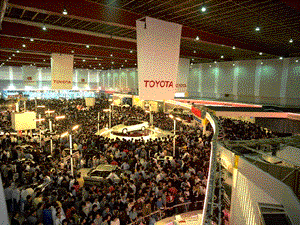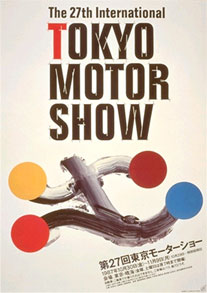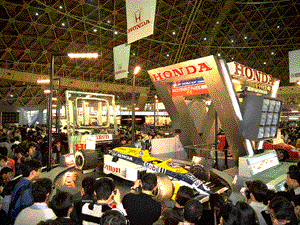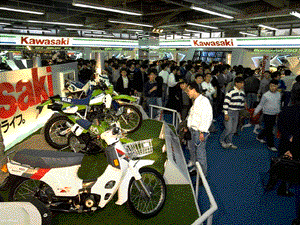 |
 |
 |
The
27th Tokyo Motor Show (1987
. 10/29 - 11/9)
 |
 |
| The 27th Tokyo Motor Show Poster |
"Enjoying Life on Wheels - Inspiring Future of Man & Vehicle"
"New life is coming in sight beyond vehicles." This is
an apt expression for these times. By driving vehicles
well, whether two-wheeled or four, man expands his sphere
of action, gains a wider perspective, and is impressed
by new discoveries. This was the background for the theme
"Pleasure of Driving, Throbbing Future of Man and Vehicles."
Today, those pursuing richer, more individual life are
seeking extremely diverse functions and symbols in vehicles.
For some young people, "speed is the vehicle." For other
people sports or communication with their friends are
associated with vehicles. And for many women drivers of
today, the vehicle as a whole is a musical space or a
fashion space.
Thus, diversity of driving pleasure has greatly influenced
vehicle manufacture itself. This is clear from the fact
that present day vehicle manufacture is inclined to make
a suggestion about life itself, rather than the intrinsic
technology or design development.
|
 |
 |
 |
As people become more individual, their lifestyles become
very diverse. And people project their images of sensitivity
and life on everyday things such as vehicles. They make
the vehicle a symbol of self-expression. In other words,
the individual identifies with the car as a part of his
or her self and seeks to make it something special that
defines his or her world. Perhaps by driving a car well,
one becomes the star of that drama and experiences driving
pleasure.
There has been no show more abundant in variety or scale
than this show. The number of visitors, 1,297,200, was
an all-time record for a 12-day show. There were many
factors behind this success.
For one thing, Japanese automakers exhibited even more
unique concept carsin an all-out effort to expand the
domestic market, due to the stronger yen making exports
more difficult. A second reason was serious participation
by American and European automakers in the show. Favored
by the appreciation of the yen, foreign car sales boomed.
The show saw full-scale participation by Western automakers
and participation by Yue Loong Motor from Taiwan for the
first time. It was really an international show joined
by 276 domestic and foreign makers, two foreign governments
and two organizations. To name a few of the many distinguished
guests who came to visit the show from overseas: Mr. Pininfarina,
President of Organisation Internationale des Constructeurs
d Automobiles (OICA), Crown Prince Frederic of Denmark,
Swedish King Gustav 16th, a number of ambassadors in Japan,
Mr. Petersen, Chairman of Ford Motor Company, Mr. Carl
H.Hahn, Chairman of VW, Mr. Von Kuenheim, Chairman of
BMW, and Mr. Calvet, Chairman of Peugeot. In addition,
vice presidents and other executives came from GM,Chrysler,
Jaguar, Fiat, Volvo and other automakers. It was the first
time that so many top auto executives visited the motor
show.
The mass media also paid greater attention than before.
Applications for telecasting increased to 10 from 2 at
the previous show. The number of domestic journalists
who visited the show was 4,875 vis-a-vis 3,980 at the
previous show. Especially remarkable was the increase
of foreign journalists from 530 to 889. This indicated
the recognition of the Tokyo Motor Show as an international
motor show abreast with the three major international
motor shows.
Growing international interest in the Tokyo Motor Show
made JMIF expandthe foreign car exhibition space to two
halls this year from one hall with two floors. As a result,
foreign car exhibition space expanded to 80% of that allotted
to the domestic cars. Exhibited were 179 vehicles by 31
companies from 6 countries and one region - the most ever.
Expansion of the exhibition area allowed more spacious
display, which helped create the atmosphere of a real
international motor show. Most enthusiastic among the
foreign participants were Europeans. After the establishment
of a Japanese corporation by BMW, other makers such as
Mercedes Benz, Volvo, and Jaguar set up Japanese units
in 1986. The exhibits from these companies reflected their
new degree of commitment. For example, brand new models
such as the Renault 21 turbo, the Ferrari F40, the BMW
318i, the Peugeot405, and the Porsche Speedster were displayed,
which was regarded as a sales offensive targeted at the
Japanese market amid the foreign car boom.
In the domestic passenger car sector, concept cars were
again very popular.The trend was to exhibit more concept
cars than new models. This was due to the growing recognition
that the reputation of concept cars would enhance the
corporate image and determine the destiny of the company.
That is why more concept cars appeared in the show than
before, and there were many cars that revealed their makers
individuality and thinking. Notable were the Toyota FXV-II,
Nissan ARC-X, and Mitsubishi HSR. All these cars shared
the intention to enhance electronic controls, and have
automatic, concentrated control of all controlling systems.
Specifically, these systems automatically controlled the
drive train, suspension, steering, brakes, driving position,
etc. according to driving conditions or weather.
Meanwhile,
the exhibition of many concept cars in which "software" -- sensitivity,
diversity and individuality -- were emphasized in addition to
new technology or "hardware," was another characteristic of
the show. One example was the Mazda MX-04 which could be dressed
up to fit the driver s mood or purpose at a given time. Other
example were the Gemini Zero Door, Isuzu s ultimate open car
for which openness was the theme, Nissan Pao, with its "retro"
mood in which individuality was emphasized, and the Elia by
which Suzuki proposed a triple box type of midget car. In general,
it seemed that products aimed at everybody s moderate satisfaction
gradually diminished, while concept cars built freely and creatively
without sticking to a ready-made concept were becoming a new
focus of the motor show.
The debut of higher class domestic cars in response to Western
cars was also a topic of the show. As foreign cars became more
available with the stronger yen and Japanese consumers increasingly
demanded larger and more gorgeous cars, Toyota announced the
wider Crown, Honda the Legend, and Nissan the Cima.
Advanced technology, new designs and new ideas were abundantly
adopted in large trucks and buses as well. Hino displayed a
large sight-seeing bus, the Grand Theater, and Isuzu the Journey
Q Royal Decker. They were the first buses with slanted windows
or slanted floors in Japan. Mercedes Benz exhibited four commercial
vehicles, including buses, for the first time, another sign
of the internationalization of the Japanese market.
To avoid congestion, show hours were extended by three and a
half hours to8:00 p.m. on Fridays and Saturdays, which was well
received. |
 |
|
|
|